Amazing properties of Suvorov (Anzur) onion-garlic
Recently, a vegetable such as onion and garlic, or Anzur, has begun to be found in the gardens. The most popular variety among lovers of this unusual plant is Suvorov's onion. In the article we will tell you whether it is edible or not and what are the secrets of growing and caring for garlic onions.
The content of the article
- Description of the variety
- Origin and development
- Chemical composition, trace elements and vitamins
- Useful properties for the human body
- Harm and contraindications to use
- Ripening period
- Yield
- Disease resistance
- Characteristics of the bulb, description of appearance, taste
- For which regions it is best suited and what is the exacting climate
- The main advantages and disadvantages of the variety
- Features of planting and growing
- Harvesting and storage
- What can be the difficulties in growing
- Tips from experienced gardeners
- Reviews of the Suvorov onion-garlic variety
- Conclusion
Description of the variety
From the point of view of biological classification, this is a plant of the genus Onion, which is part of the Onion subfamily of the Amaryllis family. The Latin name is Allium suworowii.
Often Suvorov's onion and several closely related (and therefore easily hybridizing with it) varieties are called the collective term "Anzur", which means "mountain onion" in Tajik.
Origin and development
Anzur is a wild onion that occurs naturally in the Tien Shan mountains and adjacent areas. Suvorov's bow is endemic to the Western Tien Shan. Hybrids, often grown in flower gardens and vegetable gardens, come from other onions growing in mountainous areas.
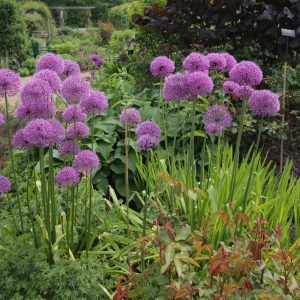 Anzur - perennial bulbous plant. Its mountainous origin has left its mark on biological features: accelerated germination with a long dormant period.
Anzur - perennial bulbous plant. Its mountainous origin has left its mark on biological features: accelerated germination with a long dormant period.
Suvorov's bow often confused with Aflatunian and Dutch. They are similar and come from approximately the same places. But the difference between them is significant: Aflatunsky and Dutch onions are often grown only as ornamental plants, and Suvorov's garlic onions are food and medicinal crops, although they also bloom beautifully.
Numerous varieties of Anzurov often have such a confusing pedigree that only DNA analysis can determine from which species of mountain wild onions they originated. There are often stable hybrids that do not have Mendelian splitting in the second generation (that is, their seeds are suitable for further vegetable cultivation).
Chemical composition, trace elements and vitamins
Suvorov's onion is extremely rich in vitamins. In terms of vitamin C content, it surpasses onions by 5 times. It also contains many vitamins B, E and mineral salts.
The exact composition depends on the growing conditions and soil: like all onions, Anzur accumulates substances from the soil.
Useful properties for the human body
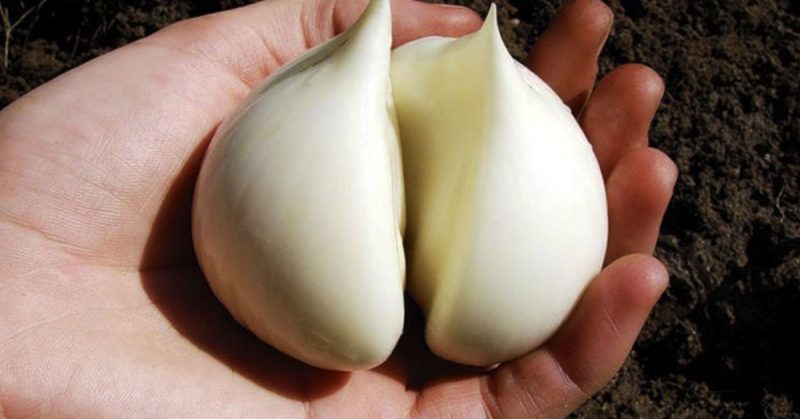
Anzur has long been used in folk medicine in Central Asia... It is believed that with regular use of mountain onions, vision becomes sharper, headaches disappear, and hand tremors decrease.
When Anzura is included in the diet, non-specific immunity is strengthened and the work of the cardiovascular system improves. This onion is used to treat vitamin deficiency.
Harm and contraindications to use
The richness of essential oils and biologically active substances that make Suvorov's onions useful in folk medicine has a downside: this onion is a strong allergen.A considerable number of people have an inborn intolerance to Anzur.
The sharpness of mountain onions can adversely affect the course of gastrointestinal diseases. In particular, with an ulcer or erosion of the walls of the stomach or intestines, it is absolutely contraindicated.
Important! In raw form, only young leaves of garlic are eaten. Eating an onion that has not passed cooking, pickling or baking, it is undesirable even for healthy people: the concentration of essential oils is so high that there is a possibility of poisoning.
Ripening period
Suvorov's bow grows slowly. In the first year after forcing the cotyledon feathers, the plant falls into a state of dormancy and forms small bulbs only before winter. In the second year, the bulbs are growing, but not yet split. And only in the third season, after wintering, it becomes suitable for consumption.
Reference. If not onion slices, but seeds were planted, the ripening period increases to 4 years.
Yield
Since Suvorov's onions are not grown on an industrial scale, no yield tests were carried out. However, according to gardeners, it is not high for this crop: from 1 m2 of a garden in the third year of cultivation, 5-6 heads are obtained, suitable for food, weighing from 150 to 300 g. That is, the maximum yield of Anzur is 1.2-1.5 kg from 1 m².
Disease resistance
Anzur has the highest endurance and resistance to disease. He suffers only from rot and fungal diseases with excessive moisture.
Also, mountain onions have practically no pests. Due to the high concentration of essential oils, insects and slugs avoid it.
Characteristics of the bulb, description of appearance, taste
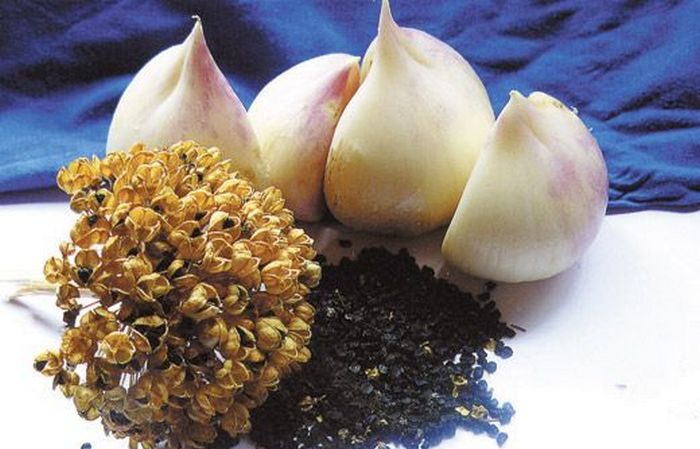
External characteristics of the Suvorov bow:
- onion with a diameter of about 3 cm in a gray shell;
- the shape of the bulb is almost round, slightly elongated upward;
- ribbed stem, up to 1 m high;
- leaves are gray-green, about 3 cm thick, rough and sinewy below;
- the umbrella is dense, from semicircular to round, about 8 cm in diameter.
The plant reproduces by seeds (then it reaches full maturity by 3-4 years) and slices from a ripe and split bulb, but the bulb does not divide in the first year.
Young leaves of the first 2-3 weeks after germination, young arrows and the bulbs themselves are eaten. Anzur is soaked in salted water or pickled before eating - this removes the excess bitterness that essential oils impart.
The taste of Anzur pickled onions resembles sour-salted cabbage stubs, which have a delicate garlic aroma that stimulates the appetite. In traditional Uzbek cuisine, pickled onions have long been used as an additional seasoning for pilaf and meat dishes. Russian gardeners rate them as an excellent snack for strong alcohol.
In addition to soaking and pickling, the onion and garlic are boiled in honey and baked over charcoal.
For which regions it is best suited and what is the exacting climate
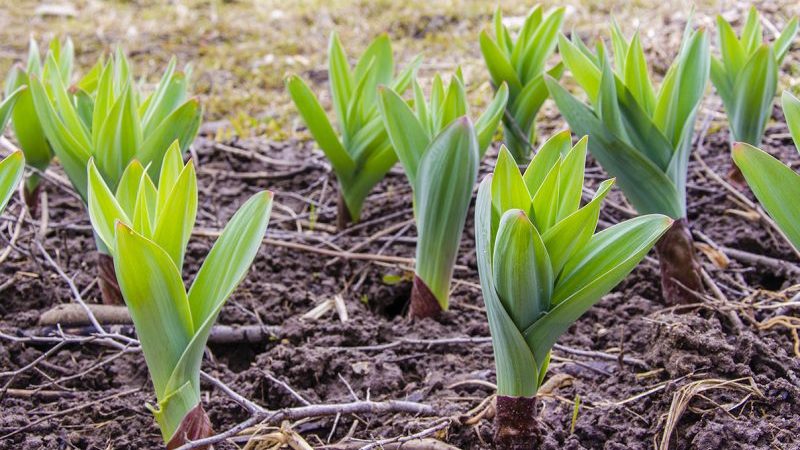
Alpine origin endowed garlic with the following properties:
- the highest frost resistance - it can freeze out only in Oymyakon, it easily transfers frosts down to -35 ° C in the soil;
- short growing season - within a couple of months after the emergence of shoots, the stems and leaves dry out, and the plant falls into a state of dormancy.
Anzur can be grown in any climate, including the Far North.
Important! In nature, Suvorov's onion grows like a weed. Until recently, it was widespread, but as a result of mass harvesting and processing, it has become a rarity. Now in Uzbekistan it is included in the Red Book, and only garden plants are eaten.
The main advantages and disadvantages of the variety
Benefits of onion and garlic: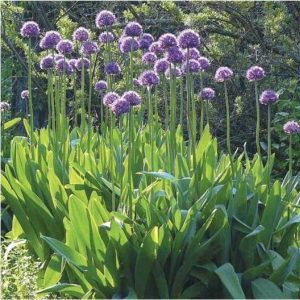
- specific, interesting taste;
- high content of vitamins;
- decorativeness - it can be grown to decorate the site, huge purple inflorescences look festive and unusual;
- undemanding care - although it is recommended to dig Anzur after falling into dormancy and plant it again before winter, you can simply leave it in the garden and forget for 3-4 years;
- medicinal properties.
However, there are also disadvantages:
- low productivity - Anzur cannot be grown in significant quantities for food in the garden, it will remain an exotic delicacy;
- the impossibility of eating raw - unlike onions and garlic, the raw Anzura bulb is not suitable for eating;
- the leaves are suitable for cutting and eating for a short period, after which they become tough;
- Anzur does not tolerate high humidity: his homeland is hot (and frosty in winter), but dry mountains, if the summer is rainy, drainage beds.
What is the difference from other varieties
There are many differences from other varieties of onions. Key for the gardener:
- low demand for care;
- low yield and short life cycle, more like tulips or gladioli;
- high decorative potential;
- the inability to eat the onion raw.
Features of planting and growing
When growing mountain onions, they are guided by the agricultural technology of winter garlic, but there are some peculiarities.
Preparing for landing
Suvorov's bow is planted in two ways:
- Seeds. They are sown before winter, shortly before frost. Before planting, the seeds are washed in a solution of copper sulfate or potassium permanganate to protect against fungi. Stratification may also be required - freezing seed in wet sand.
- Lobules. They are planted at the same time using the same treatment.
Ground requirements
Suvorov's onion and garlic are not picky about soil... He prefers loose black soil, but can grow on any soil. Soil characteristics for Anzur:
- humidity - Anzur tolerates dryness better than excessive moisture;
- acidity - Suvorov's onion prefers a neutral environment, therefore liming is carried out on acidified soils.
Timing, scheme and landing rules
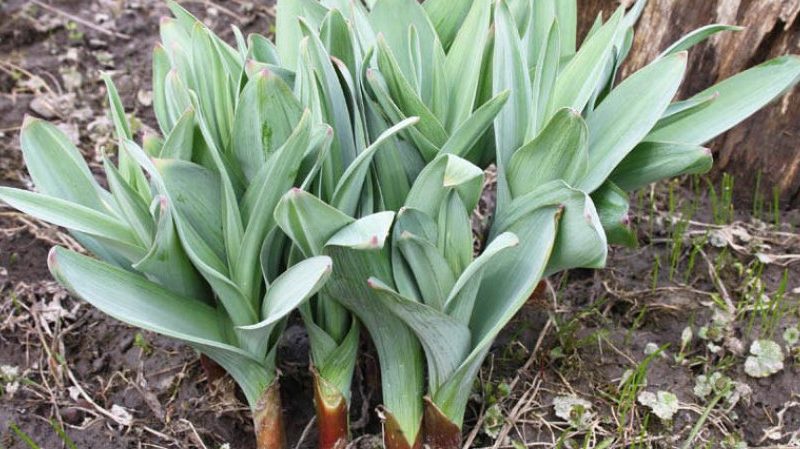
Seeds are planted 2 cm deep at a distance of 25 cm from each other. When planting small bulbs or slices, they are embedded 5 cm deep, also according to a square-nesting scheme with a distance of 25 cm from the nearest hole. Small bulbs are planted in the soil no later than November, so that they can take root.
Landing is done:
- in spring after winter stratification;
- in the fall, 1-2 weeks before frost.
Growing features
After the onion is sown, it only needs the following:
- regular watering without crusting;
- timely digging after the onset of dormant time, if this is not done, the yield will decrease;
- removal of seed shoots - they take resources from the bulb (this is done if Anzur onions are grown for food).
The nuances of care
Anzur does not need special care. Enough regular watering without waterlogging, detrimental to the culture, and the introduction of organic or complex fertilizers 2-3 times into the soil.
Watering mode
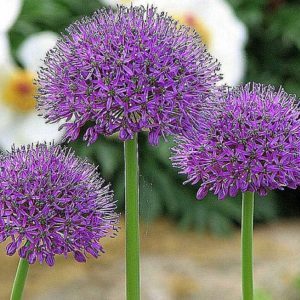
Suvorov's bow does not need frequent watering... If the weather is dry, water it once a day - in the morning or late in the evening, when the sun is not high.
The norm for watering is a situation when a lump of soil taken from a garden bed easily sticks together and also easily crumbles when pressed.
Loosening the soil and weeding
Like any bulbous plants, mountain onions need regular loosening and weeding for good yields. Weed as weeds appear, and loosen at least once a week.
Top dressing
Suvorov's onion does not need specific feeding. It is enough to add a set of fertilizers for winter planting - humus and 20-30 g of superphosphate per 1 m². When feeding in the spring, more calcium and phosphorus fertilizers are added than potash. Overfeeding with nitrate is fraught with the fact that the green mass will be powerful, but the bulb will not.
Disease and pest control
Diseases and pests of onion-garlic are not scary, but for prevention, seeds and slices are treated with copper sulfate or potassium permanganate from fungi.
After planting, the bed is spilled with a solution of "Fitosporin-M".
Harvesting and storage
Stages of harvesting onion and garlic:
- digging (usually with a pitchfork so as not to damage the bulbs);
- withering in the sun and draft;
- clearing the ground, pruning roots and stems.
How and when to collect
Collect the bulbs after the leaves and peduncles are completely dry (if left behind). For use the largest specimens are selected, and the trifle is left for pre-winter planting.
Storage features and keeping quality of the variety
The storage of Suvorov's onions is no different from onions and garlic. At a temperature of + 2 ... + 4 ° C and a humidity of 80%, the bulbs are stored in a dark room for 3-4 months.
What can be the difficulties in growing
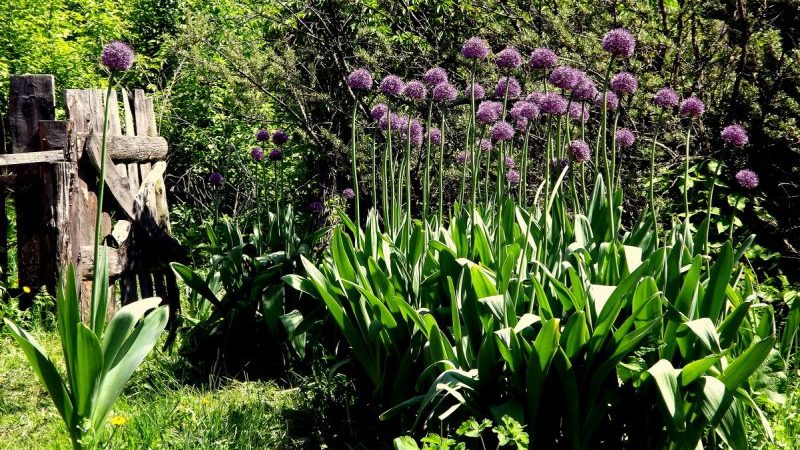
There are no special problems with Suvorov's garlic onions. Pay attention to:
- Timely removal of peduncles. Arrows are left if mountain onions are grown for beauty. But if you need food bulbs, the arrows are cut out.
- Compliance with the watering regime. Suvorov's bow rots when waterlogged.
Tips from experienced gardeners
Experienced gardeners advise the following:
- use more phosphorus than potassium fertilizers;
- avoid thickening - it is better to dig up small bulbs and store them before planting before winter than to leave them in the soil.
Reviews of the Suvorov onion-garlic variety
Here's what gardeners who tried to grow this unusual garlic onion on their plots say about this plant.
Inna, Barnaul: «Not a bad variety, good for decoration and seasoning. I haven’t tested the medicinal properties ”.
Irina, Orsk: “The plant is unpretentious, give it free rein - the whole area will fill. But why it is needed is not clear. I admire the umbrellas, they are big, as in the photo, but I don't eat like that - they are bitter and tasteless onions. "
Ekaterina, Novotroitsk: “Delicious seasoning! We sowed for beauty - and now every year we take out 5-6 onions for food and add a piece to pickled cucumbers and tomatoes. It's just a pity that a lot of little things die during digging: you can't leave it, it degenerates in just a year. We haven’t planted seeds yet - we don’t have enough patience ”.
Conclusion
Suvorov's onion-garlic, aka Anzur, is a non-standard plant in the garden. It cannot replace traditional onions or garlic, but it will be an interesting addition to winter harvesting. It will be especially appreciated by gardeners who are interested in beauty, and not the yield of the site.